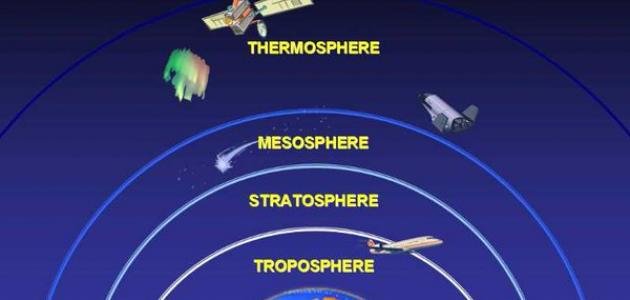
The atmosphere is defined as a layer consisting of a group of different gases, which in turn surrounds a body with a particular mass and is affected by gravity. This mass is retained for as long as possible if the earth's gravity is high, the temperature is low, For example, the atmosphere of some planets is only an outer layer that encapsulates and protects them. Atmospheric composition The dry atmosphere is composed of a group of gases, but oxygen, nitrogen, and argon, together with carbon dioxide, together account for 99.98% of the total volume of air, while the total volume of the remaining gases is 0.02% Oxygen is the most important of these gases when it comes to human life in order to enable it to carry out the breathing process, as necessary until the combustion process that produces and exhales carbon dioxide, both to humans and animals, and plants in turn absorb and return to the atmosphere in the form of oxygen during What is known as the process of Photosynthesis. The atmosphere is composed not only of the air but also a quantity of water vapor. Its air content varies between 4% to very large so that the air is then saturated with moisture, as well as granules of fine size soil, Cigarettes are added to the dust, so they are all suspended in the air, and these dusts in turn absorb a fraction of the sunlight, which in turn helps in the reflection and thus the spread of radiation. It is worth noting that the color of the blue sky and the color of the red sunset due to the effect of mixing dust with different gases, and this causes our vision of blue and ultraviolet radiation, which means that if the process of propagation of dust and steam in the atmosphere, the color of the sky was black, The planets at night are luminous. Atmospheric sections The troposphere is the layer on the Earth's surface directly, with a thickness of twelve kilometers, which makes up about three-quarters of the total weight of the atmosphere, although it is the most disturbed and disturbing layer, the bottom of which is about three Kilometers, characterized by a low temperature, ranging from twenty-one to twenty-seven degrees Celsius below zero. The stratosphere When the temperature begins to rise, the layer starts to appear on the top of the troposphere. It is about eighty kilometers above sea level, and the imbalances are aerobic, with a peak of 20 kilometers in the bottom layer, Where ozone gas is particularly large at a distance of 15 km to 45 km above sea level. The mesosphere layer is located behind the upper limbs in the stratosphere, which is separated by the stratosphere, and has an especially high temperature in the lower part of it, and decreases as we rise to the top. The stratosphere is also called the ether layer. The distance between its lower limbs and the surface of the sea is about eighty kilometers. Its dimensions are determined by the concentration of ionic particles in them, which in turn affect radio waves as well as electromagnetic ones.
Please remove the #deutsch tag, which should only be used for posts in written in german language.